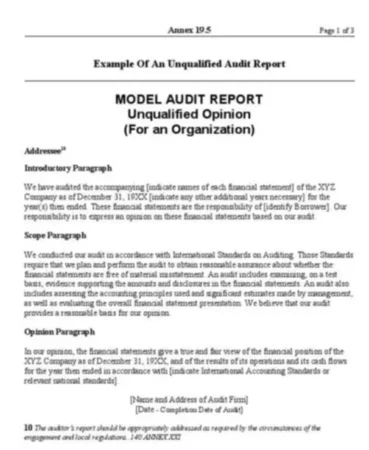What is an Auditor’s Report?
An auditor’s report can be defined as an organized statement of facts relating to the audit of books of account of the company prepared after an inquiry to give clear and concise information to persons who are not already in possession of the full facts of the subject matter of the report. Thus, an audit report is given by an auditor to enable the investors, creditors and other users to use this opinion in their decision-making. Therefore, it is imperative that the auditor is unbiased, objective, independent, and with a clear mental attitude.
It is required to have an audit in order to be a publicly-traded company, which will be the one hiring an auditor. The audit is in essence or to some degree is a type of check or regulation on very large companies that have a separation of duties or less direct management. A compliance audit and an operational audit are other examples of different audits a company can get.
The Components of an Auditor’s Report
An audit report is usually prepared in the standard format as prescribed by regulating standards related to auditing. The rules will slightly different and usually be more stringent for publicly traded companies, larger companies. This standardization helps to know what the audit report would look like if we have some problems, some areas where the financial reports do not line up exactly with what we hope they would, and we cannot issue a “clean” report.
First, let’s look at the basic structure. The report will begin with a title line, which includes the report title and name of the Independent Registered Public Accounting Firm, which gives some assurance to the reader of the report because it is saying that the individual/firm is independent and not invested in the organization. The report should be addressed to the person/s to whom it should be forwarded.
Next, you will see an opening or introductory paragraph. It will include the following elements:
- Financial reports being audited — they are identified by the name of the organization and the period covered;
- Clear marking of responsibility — the responsibility of the entity’s management and auditor’s responsibility.
It is followed by a scope paragraph, which should specify the nature and scope of the work performed by the auditing firm. An opinion paragraph is next. It should clearly specify the financial reporting framework. The report will end with the:
- CPA firm’s and the auditor’s signature
- Location where the report is provided
- Date the report is signed.

Now, let’s look at the different opinions that the auditors can issue based on their findings. This opinion will be stated at the top of the front page for the users to see the final decision right away.
- Unqualified/Clean Report
An unqualified audit typically means that the audit opinion of the accountant that audited the books of the company (auditor) has an unqualified opinion or, in other words, it is a clean bill of health. This means that the audit was performed and the company complied with all the audit procedures and there were no material, misstatements or deviations from the accounting rules and principles.
- Qualified
If the statements contain a deviation or misstatement that is considered material and management refuses to correct the misstatement (maybe even for a good reason) or if the auditor is unable to obtain sufficient evidence regarding a specific account, the auditor might have some qualifications. In this case, we would say that it is not totally unqualified. The auditor will say that this and that looks good, except for this qualification. The report user need to know and understand why this opinion was qualified and under what circumstances to really understand what the reasons were that the auditor found this deviation from standard practices and/or rules in this company.
- Adverse
The auditee’s documents might contain a misstatement that the auditor considers so material that it adversely affects the interpretation of the financial reports. In this case, the auditor will issue an adverse opinion, indicating that one should not rely on the financial reports because they are not fairly stated. Obviously, the company might not be very happy with it. Thus, sometimes, the auditor’s engagement with the company may end before the process is over or the auditor will issue a disclaimer.
- Disclaimer
If the scope of limitation is large enough that it limits the ability of the auditor to make an opinion, then a disclaimer is issued. Here, the auditor is saying that he or she is unable to give an opinion because it is not possible for them to get access to the information they need (either for legitimate reasons or not). For example, majority of the company is located in another country and the auditor does not have access to required documents.
Auditor’s Report Example
Finally, take a look at an example of an auditor’s report prepared for an organization. As you can see, it follows the basic format described above and is fairly short. If there were some issues found, this report would be longer.


















